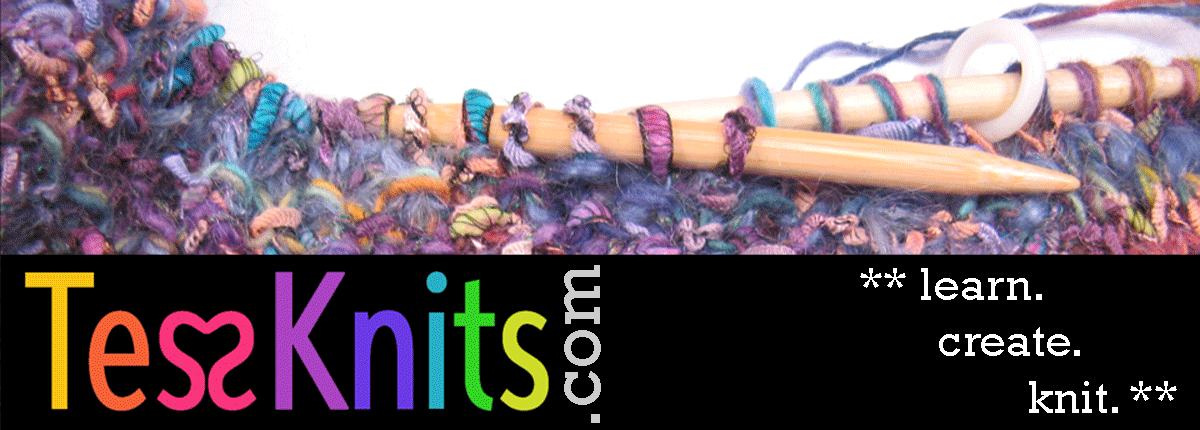Many knitters get confused over the directive to “slip” a stitch.
To slip a stitch means simply to move it from one needle to the other. That’s all that “slip”, by itself, means.
Once I had a student arguing with me that “it can’t be that easy!” but believe me, it is.
Of course, it gets a little more complicated with the choices you have on exactly how to do that. Here are the choices to be made (or directions to be followed, if they are given).
(1) Direction of slipping = forwards or backwards
“Slip” by itself usually means from left needle to right needle, in the usual direction that stitches move.
“Slip [the st] back” usually means the other direction, from right needle to left needle.
(2) Placement of working yarn = in front of work or in back of work
Generally speaking, leave the working yarn on whichever side of the work it is on, unless you are told differently.
The abbreviations used to tell you to switch the yarn to one side of the work or the other, before slipping the st, are varied: but knowing that you only have two choices, and if they are telling you to move the yarn it can only go to whatever side it’s not already on, you can usually figure it out. A couple of them are:
- wyif = with yarn in front, wyib = with yarn in back
- yf = yarn forward, yb = yarn back
- wf = wool forward, wb = wool back (UK)
- alternatively, the directions may state where the yarn should be in terms of RS (right side) of work or WS (wrong side) of work.
(3) Orientation of stitch = flipped or not flipped = knitwise or purlwise
Here is where the most confusion usually is. But it’s simple if you already know about proper stitch mount.
First, FORGET the idea that slipping knitwise or purlwise has anything at all to do with whether you are on a knit row or a purl row. You can slip sts knitwise on a purl row, or purlwise on a knit row. The two are entirely, 100% unrelated.
Slipping purlwise does nothing to the stitch except move it over. If you insert the right needle purlwise into a st, and then raise your elbows (the “chicken wing” maneuver), you’ll see that the points of your needles go end-to-end. It’s like your needles are a curtain rod and your stitches are like curtain rings. You can move sts back and forth this way all day long and they don’t change their orientation, just like your curtain rings don’t turn around when you slide them along the curtain rod.
Slipping knitwise, however, flips the st so it is facing the other way. Try it, and look at the base of the stitch in particular, until you can see what this means.
So, the question of whether to slip knitwise or purlwise boils down to, “do I want to turn this st around or not?”
Rule 1: If “knitwise/as if to knit” or “purlwise/as if to purl” are spelled out, do whatever the directions say to do.
Rule 2: If it is not specified, then purlwise is the default. Most of the time, we do not want to turn sts around, except…
Rule 3: If you are doing a left-leaning decrease – any decrease technique with a “slip” in it, like SSK, SKP or SSP – always slip the sts knitwise.
(Disclaimer: This applies to all single decreases; it also applies to many double decreases. BUT there are many many ways to do double decreases, depending on the final effect desired – so it may not apply to every single one of those.)
One way to think about it is this: If you wanted a right-leaning decrease, you’d just do a K2tog, right? So, if you are even bothering with doing an SSK or an SKP, it’s because you want it to lean the other way — which means you have to flip at least one of your sts around so it will lean to the left when all is said and done.
Rule 4: For many selvedge techniques, the idea is to twist the end sts so they do not pooch out, as well as to stretch them over 2 rows. So slipping a st knitwise as a selvedge is very common.
* SSK = slip, slip, knit = left leaning decrease technique: mirrors K2tog.
* SKP = slip, knit, pass = slip 1, knit 1, psso (psso = pass slipped st over).
SSK and SKP are two different ways of achieving exactly the same structure. They are interchangeable. Learn them both and pick the one you prefer to work, or the one that looks best.
* SSP = slip, slip, purl = left leaning decrease done on the WS.
One popular place where I have noticed a potentially confusing description is where Knitty says in their abbreviations list that “sl” = slip and “slp” = slip 1 as if to purl.
In most of the knitting world, these two are considered to be the same thing: i.e. if you’re just going to “slip”, then, following the rules above, it IS going to be purlwise.
I have not seen a separate abbreviation on their list for “slip 1 knitwise” — apparently you’ve got to spell that one out . But, one might be led to believe from this omission that if “slp” means purlwise, then a plain ol’ “sl” must therefore mean knitwise – which is generally not the case.

2 comments for “Slipping Stitches In Knitting”